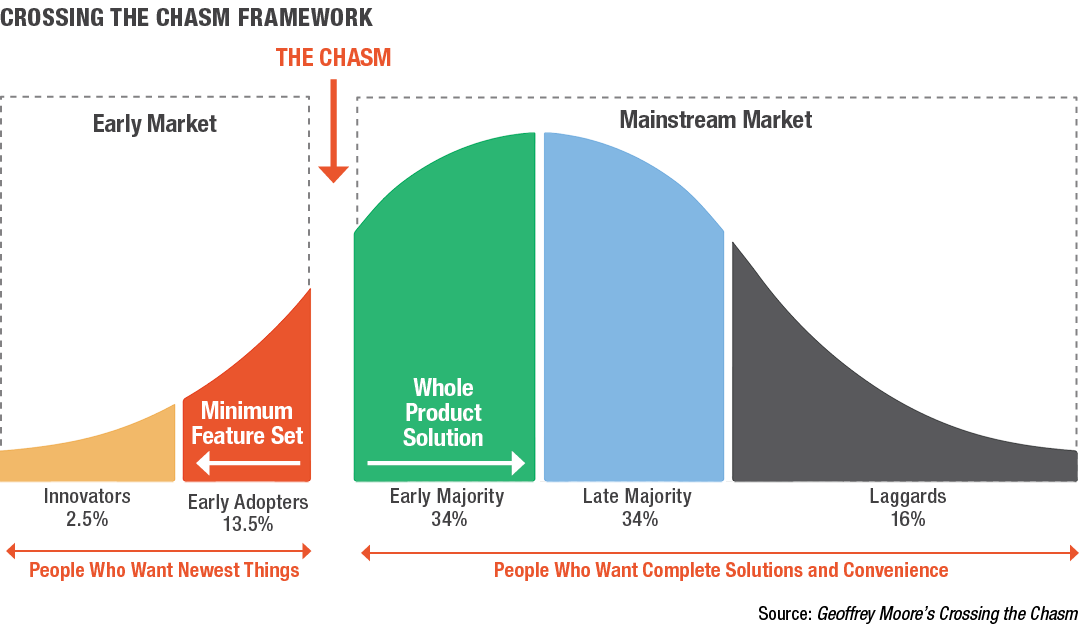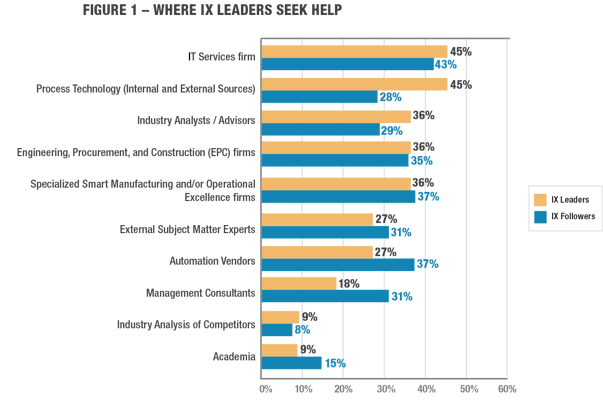In our 2021 Industrial Transformation (IX) Readiness research, we asked more than 300 industrial companies where they were on their IX journey. Since our 2019 study, the share of companies fully committed to the journey soared from 16% to 28% - crossing the proverbial chasm. Conversely, the share of companies “stuck in pilot purgatory” fell from 13% to 7%.

This new data represents tremendous news and progress for the industry. It means Industrial Transformation (IX) is moving mainstream. Next-generation programs like Industry 4.0 and Smart Manufacturing will soon be as prevalent as last-generation programs like World Class Manufacturing and Operational Excellence, likely ushering in a new wave of productivity gains across a huge swath of the economy.
However, these results stand in stark contrast to what has been reported by McKinsey, which in 2019 found 56% of manufacturers are stuck in pilot and reported in 2020 this number increased to 74% of manufacturers.
So why is there such a big difference in the data sets?
One answer could be the focus and import that McKinsey and others in the industry have placed on lighthouse plants. Although no one can argue with the technological innovation and productivity gains that lighthouse plants demonstrate, our data shows that including lighthouse plants as part of your Industrial Transformation (IX) program does not correlate to success.

In fact, when we examine the responsibilities of the IX program team, we find that Leaders are 30% less likely than Followers to include a lighthouse plant as part of the team’s responsibility. So why is it that lighthouse plants likely contribute to the problem of pilot purgatory rather than solve it?
-
Lighthouse plants can lead to a mindset that focuses on technology testing and implementation rather than on a focus on solving business problems. 
-
Lighthouse plants add strengths to strengths. But how much benefit does the company get moving a lighthouse plant from 99.9% first pass yield to 99.99% or going from .05% unplanned downtime to .03%? There is often much more to be gained by moving the bottom half of plants from 85% first pass yield to 95% or from 7% unplanned downtime to 3%.
-
Lighthouse plants, by definition, build something that is not repeatable or scalable. If every plant is a lighthouse – is no plant a lighthouse?
-
The resources used to build lighthouse plants typically are not suitable for scaling globally. Often, they include local plant resources combined with highly specialized external resources, which may be able to help scale to a few plants - but they have a day job to eventually return to that is not scaling change across a plant network. The lighthouse plant personnel will return home and the highly specialized external resources will move on to building another lighthouse plant – probably for your competitor.
-
Finally, cost. Companies easily spend $10 million+ on “digitizing” a lighthouse plant. But if a company has another 100 plants to go, do they have a $1+ billion digital manufacturing budget for the next 3-5 years? Very doubtful.

So, what should companies do instead of building Lighthouse plants?
Our research shows that Leaders are 25% more likely than Followers to build an Industrial Transformation Center of Excellence. So why is it that Industrial Transformation Centers of Excellence (CoE) are so much more successful at scaling change and driving transformation than lighthouse plants?
- IX Centers of Excellence specifically build change management capabilities that are prepared to deploy globally at scale.
- IX Centers of Excellence invest in maturity assessment capabilities that can help organizations understand the range of plant maturity in the network and target improvements that yield the greatest organizational benefit.
- IX Centers of Excellence build templates and roadmaps that align to plant
 maturity/modes of manufacturing and extend operational architectures - simplifying and accelerating the deployment of change across sites.
maturity/modes of manufacturing and extend operational architectures - simplifying and accelerating the deployment of change across sites.
- IX Centers of Excellence directly engage with plants through innovation workshops that help plants both identify problems and choose solutions, aligned with global scale. This helps address issues of top-down vs. bottom-up change.
- IX Centers of Excellence support education and upskilling for digital capabilities relevant to and in the language of industrial operations.
- IX Centers of Excellence can include an innovation center, which can pilot and test technology – but in the context of building capabilities that solve specific and pressing business problems, not implementing technology categories.
- IX Centers of Excellence are cross-functional and can help address common cultural and/or organizational disconnects, including:
- Bringing together IT and OT
- Bringing together Engineering and Data Science
- Including Quality and EHS
- Including the extended value chain of Product Development and Supply Chain
- Including or building from existing Continuous Improvement programs like Lean, TPM, WCM, or OpEx
Next Steps
If your organization is currently pursuing a lighthouse plant-centric strategy to drive Industrial Transformation (IX), I hope this new research gives you pause. It does not mean you have to stop current activities – but perhaps spend less time and marketing energy focused on building strengths on strengths with a lighthouse plant. Instead, create balance with a focus on an IX CoE, building scalable change management capabilities to move the rest of the organization more quickly.
And, if your organization has not yet created a lighthouse plant, perhaps there was wisdom in your decision to refrain – but do not let that hesitancy carry over to slowing down the overall transformation initiative or the deployment of an IX CoE.
Where to Look for Help
All this raises the question of where companies should seek help with their IX program. As one example, LNS’s research in the process industry reveals that IX Leaders are significantly more likely to leverage process technology companies or industry analysts/advisors, including within their own company’s ranks.
 In a sense, these groups that correlate to success have a fiduciary responsibility to their clients and to seeing them make lasting change; atypical of many other suppliers that IX Followers are more likely to use, which are often more interested in selling the next big consulting project, additional implementation services, and/or hardware or software products.
In a sense, these groups that correlate to success have a fiduciary responsibility to their clients and to seeing them make lasting change; atypical of many other suppliers that IX Followers are more likely to use, which are often more interested in selling the next big consulting project, additional implementation services, and/or hardware or software products.
